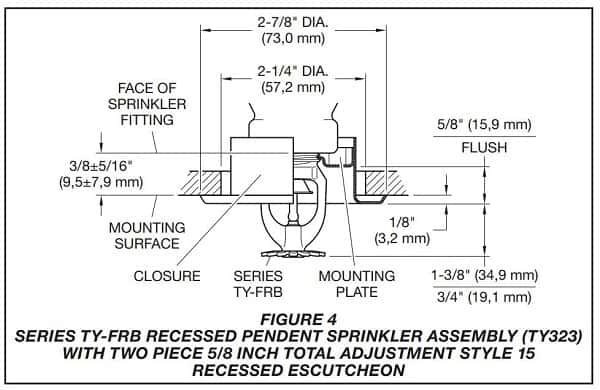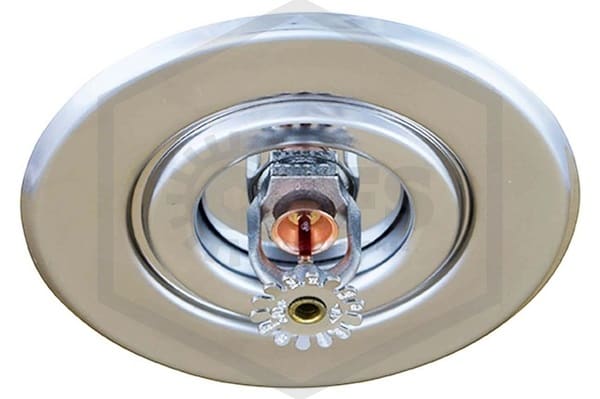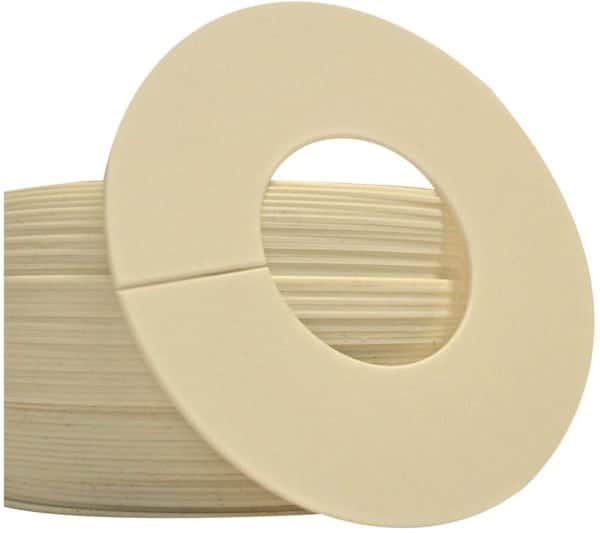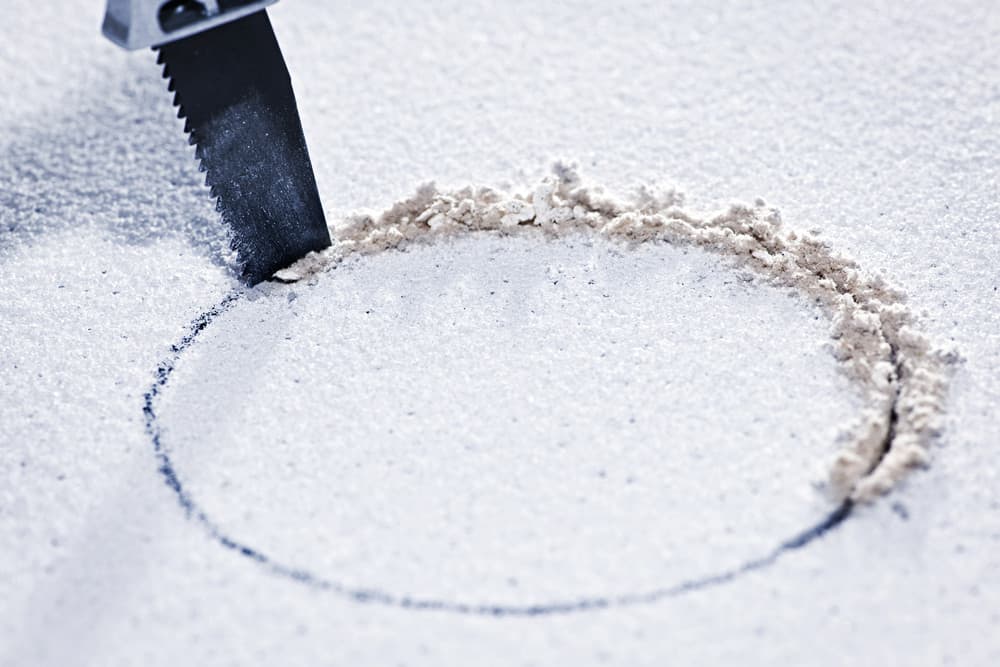When escutcheons or cover plates are too small, trim rings can fill in oversized “annular spaces” around fire sprinklers
Fire sprinkler escutcheons and cover plates provide a clean, finished appearance for pendent and sidewall sprinklers. Both fill in the gap between sprinkler heads and the edges of the holes in walls or ceilings that expose them, also helping ensure that sprinklers work properly.
But sometimes, the hole is too big — no escutcheon or cover listed for use with the sprinkler can fill the gap. This can happen by mistake or be part of seismic design measures that protect sprinklers in earthquake-prone areas.
Whether oversized holes are intentional or not, significant gaps around a sprinkler need to be filled. And if no available escutcheon or cover can do the job, fire sprinkler trim rings are a solution.
Also called “oops rings,” “expansion plates,” and “extension rings,” these metal or Kydex plastic circles act like a bigger escutcheon, filling the space between a listed escutcheon or cover and the wall or ceiling.
Read on to discover why you need escutcheons, why installation errors or seismic protection create larger gaps, and how trim rings address oversized holes.
Whether for an “oops” or seismic protection, QRFS has the trim rings you need. Also, check out our fire sprinkler escutcheons and concealed sprinkler cover plates from Reliable, Senju, Tyco, Victaulic, and Viking.
Fire sprinkler escutcheons and covers are aesthetic and functional
Escutcheons and covers make sprinklers look nice, but they’re also functional. Covers conceal sprinklers and holes while detaching at a specified temperature (usually about 20°F lower than the sprinkler’s activation temperature), exposing the sprinkler head so it can do its job.
Listed flush or recessed escutcheons provide a clean and finished appearance for exposed sprinklers and can also keep the sprinkler in position while ensuring the correct water spray pattern and activation time.
Sprinkler position and water spray for listed sprinkler assemblies
Escutcheons play an essential role in the installation of recessed, flush, and even concealed fire sprinklers (though an “escutcheon” in the case of concealed sprinklers refers to the “sprinkler cup,” which is different than separate fire sprinkler escutcheon plates for exposed installations).
In addition to a sprinkler head’s basic listing and performance characteristics, sprinklers installed in these ways are separately tested and listed as entire assemblies, which include the escutcheons or covers that fill gaps and may help hold them in place.

The explanatory content from NFPA 13: Standard for the Installation of Sprinkler Systems (2022 edition) elaborates on the role of a complete sprinkler assembly:
7.2.6.2 The listing of these components ensures that the sprinkler, escutcheon, and cover plate combination will operate as intended and not adversely affect the discharge pattern of the sprinkler.
In other words, the entire assembly, including the escutcheon or cover, is necessary to ensure proper water spray. This is one reason missing listed escutcheons and covers must be replaced, as section 5.2.1.1.5 of NFPA 25: Standard for the Inspection, Testing, and Maintenance of Water-Based Fire Protection Systems (2023 edition) states. So, you also can’t go without them just because the hole in the ceiling is too big.
However, NFPA 25 also says that escutcheons don’t need to be replaced if they are not part of listed assemblies. They may not look as pretty, but exposed fire sprinklers that simply hang from visible pipes don’t need escutcheons (nor covers, since they aren’t concealed) at all.
Escutcheons, gaps, and heat escape
Another commonly cited reason that escutcheons are necessary is to enable the on-time activation of fire sprinklers. The idea is that gaps around the sprinkler head might allow rising hot gases to escape into the ceiling or wall, delaying the accumulation of heat around the temperature-sensitive element of the sprinkler and potentially delaying its activation.
There is some debate over the potential impact of missing escutcheons on activation times, with a previous edition of the NFPA 25 Handbook calling the impact “negligible.” But at least one manufacturer’s representative has stated during a revision cycle for NFPA standards that because the company tests entire sprinkler assemblies together, missing escutcheons may influence a sprinkler’s thermal sensitivity. (You can read more about this debate in an upcoming QRFS blog!)
In any case, it’s generally better to be safe than sorry when it comes to sprinkler activation or impaired water spray patterns, and missing listed escutcheons (or covers) are considered a noncritical deficiency by NFPA 25. Thus, you need to replace them!
Seismic protection may require larger gaps around sprinklers
Fire sprinklers are sometimes intentionally installed with larger holes for seismic protection purposes. We’ve previously written about how seismic design principles protect fire sprinkler systems from earthquakes. One core technique uses oversized holes where sprinklers or pipes penetrate walls, floors, and ceilings. This extra “annular space” can prevent the equipment from breaking against the structure as the building shakes.
NFPA 13 (2022) provides the following rules for fire sprinkler clearance in seismic design:
18.4.11* The installed clearance between a sprinkler and structural elements not used collectively or independently to support the sprinklers shall be at least 3 in. (75 mm).
18.4.11.1 Where sprinklers are installed using flexible sprinkler hose, clearance for the sprinkler shall not be required.
Some extra-large escutcheons are available to fill these more significant gaps, such as Viking’s NP-3 escutcheon with a 5 1/8” outer diameter. But not every manufacturer makes larger, listed seismic escutcheons, so fire sprinkler trim rings may serve for extra-large holes.
Metal fire sprinkler trim rings or Kydex split rings can cover big holes
Whatever the reason, oversized holes around sprinklers often need to be covered. Unless a large cover plate or escutcheon (like Viking’s) is available for a given model, the go-to solution is a metal trim ring or a plastic Kydex ring.
Also sometimes called “oops rings,” “extension plates,” or “extension rings,” trim rings are metallic or plastic plates that essentially extend the diameter of an existing escutcheon or cover plate. They can never replace listed escutcheons, and certainly not covers. Instead, they simply help ensure a clean finish and fit.
Metal fire sprinkler trim rings
Trim rings are simple metal rings that fit around the sprinkler and escutcheon or cover, installing between the latter and the ceiling or wall. You can almost think of a trim ring as an escutcheon for your escutcheon or cover.

Trim rings have two primary dimensions: their outer and inner diameters. The outer diameter determines what size hole you can cover, and the ring should be a bit bigger than the hole. Outer diameters of 4.5″ and 5″ are typical for metal trim rings.
The inner diameter, which is the size of the hole in the ring, determines where the trim ring can fit. A 2” inner diameter is sufficient to fit over most escutcheons, and you’ll need 2 3/8” to fit around the cup and plate of most concealed sprinklers.
Kydex split rings
Metal trim rings are not the only option, however. Kydex rings are made of fire-rated plastic instead of metal. As section 16.2.5.1 of NFPA 13 says, you should never use plastic fire protection parts unless a piece of equipment is specifically tested and listed. Kydex is a brand of heat-resistant thermoplastic that is listed for such use.

Plastic trim rings have some advantages. First, they are a less-expensive option. Second, Kydex rings are flexible, cuttable, and split-ring rather than a solid piece, which makes them easy to install and remove without removing the sprinkler. Kydex rings come in a 4-1/16″ outer diameter and 1 3/4″ or 2″ inner diameters. The outer and inner diameters could be modified by cutting them, however.
That all said, metal trim rings have one potential advantage: they often look better!
Trim rings fill in ugly gaps and enable a clean installation
When the hole cut to accommodate a sprinkler is too big, you often need a trim ring to fill the void. Whether this gap is due to a mistake or for seismic protection purposes, trim rings and Kydex rings enable clean installations, hiding the subceiling or wall’s interior and concealing the ragged edge of the cut.
For your next project, QRFS has the metal and Kydex trim rings you need to cover any oversized holes. Plus, we have a wide range of escutcheons and concealed sprinkler cover plates from Reliable, Senju, Tyco, Victaulic, and Viking.
If you have any questions or need help placing an order, call us at 888-361-6662 or email support@qrfs.com.
This blog was originally posted at QRFS.com/blog. If this article helped you, check us out at Facebook.com/QuickResponseFireSupply or Twitter @QuickResponseFS.



How do you keep the trim rings from falling off the ceiling? We live by railroad tracks and the vibration knocks them off the ceiling..is there an adhesive????
Penny — trim rings are designed to fit around and be held in place by the escutcheons, which essentially ‘pin them’ to the ceiling or wall. If yours are falling off, it’s likely that something (sizing, etc.) is not right. You should contact a qualified fire protection contractor to look at the situation.